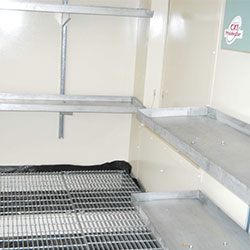Improper chemical storage in the shipyard can prevent your maritime operation from receiving a clean bill of health before its maiden voyage into fiscally sound waters. Shipyards are one of the world’s most dangerous workplaces. Common shipyard hazards can leave any nautical outfit high and dry as they to recover from hefty port fees and civil penalties. The typical shipyard worker faces daily exposure to asbestos, paints, thinners, lubricants and solvents. Combustible liquid storage lockers can help your shipyard maintain chemical compliance from stern-to-stern with fire-rated protection.

Working in a shipyard as almost as dangerous as making a living in a mine. They must contend with hot work in confided spaces with poor ventilation. There also a prevailing feeling of doom from the natural elements, such as suffocation and sudden structural collapse. And like coal miners who breath a lifetime of toxic fumes and dust, many shipyard workers face chronic illness due to respiratory infectors brought on by exposure to heavy metals and asbestos. Between 2011-2017 it was reported than nearly 50 fatal accidents took place in U.S. shipyards, surpassing the rate for all American employees. An additional 60,000 employees were injured in non-fatal accidents. With such a propensity for accidents, shipping operations will want to avoid being the scuttlebutt of any port by investing in steel-gauge fire rated storage protection from U.S. Hazmat Storage. Hefty civil fees can take the wind out of the sails of the most prosperous operations.
Fire-rated warehouses can streamline shipping operations

Before port inspectors and OSHA fire the first warning shot across your bow for improper storage, receive a free consultation from one of our experienced building advisors. They can astutely evaluate your needs and offer a practical and affordable storage solution that can be easily transported or relocated to your shipyard. Ports and shipyards are bustling operations. Millions of pounds of cargo and thousands of personnel travel through these nautical stations daily. Even before the Industrial Revolution, shipyards were global cities that were bridges to far off places and distant cultures. They were also the port of entry for new and exotic goods, as well as outgoing wares. Entire economies rode on the safety and sustainability of shipyards. To buoy the growing demands of ports, shipyards must maintain ample room, supplies and tools to routinely repair ships and boats.
Combustible liquid storage lockers can help store dangerous lubricants and fuels during routine maintenance

Fires are an insidious and growing threat on any ship. Cargo ships and ocean liners not only contain a large amount of flammable materials and fuels, but they also house various chemicals that are necessary for routine maintenance. Ships and boats are especially susceptible to fires during repairs and downtime. Firstly, there are typically few seaman on deck during these periods, so there’s less manpower to combat the blaze. Errant sparks from welding a debris cluttered environment could also make any shipping a prime kindling box. U.S Hazmat Storage’s four-hour fire rated storage lockers would be ideal for storing flammable materials, acids and corrosives while repairmen performed much needed maintenance. Just like a shipping container, these storage lockers could be easily hoisted onto a cargo ship via crane or could standby on docks. Repairmen and crew alike could easily access hazardous materials from the combustible liquid storage lockers before and after repairs.


